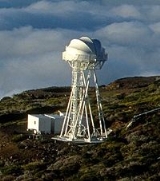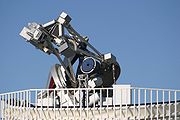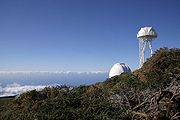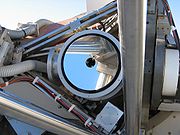
Dutch Open Telescope
Encyclopedia
The Dutch Open Telescope (DOT), located on Roque de los Muchachos Observatory
, La Palma
(near the Swedish 1-m Solar Telescope
), is an optical solar telescope
with a main mirror of 45 centimeter and can reach an 0.2 arcsec resolution for sustained periods. For further optimization of the images, the DOT uses the image despeckle mechanism. One of the successes was the recording of the 2004 Venus transit
, the movies recorded can be seen at the DOT website.

 The DOT is an open telescope, which means that the structure is physically open, and the wind can blow through. Because the wind blows along the mirror the air has a more or less constant temperature, and this prevents seeing
The DOT is an open telescope, which means that the structure is physically open, and the wind can blow through. Because the wind blows along the mirror the air has a more or less constant temperature, and this prevents seeing
. Conventional telescope designs have the problem that hot air from the ground (which is hotter due to solar heating) is blown up along the tower, and this causes air with different temperatures to blow along the telescope, which degrades the image.
A drawback of this open structure is that the skeleton has to be very rigid (do not confuse with strong), to prevent the structure to move in the wind. Normally a solid tower takes care of this (as is done with the Swedish 1-m Solar Telescope
(SST), for example), or the telescope is placed inside a dome. The DOT does not have this and thus has to be very rigid. The optical part of the telescope is mounted 2 meters in front of the main mirror, and to prevent blurred images, the cameras are mounted very rigidly and can move with a precision of micrometres.
 Another novel feature of the DOT is the roof which is made of a special polymer fibre which retains its shape after being stretched and does not loosen after time. The shape of the several roof sections are made in such a way that they are always under tension when closed, so it is stronger (i.e., the sections are saddle-shaped).
Another novel feature of the DOT is the roof which is made of a special polymer fibre which retains its shape after being stretched and does not loosen after time. The shape of the several roof sections are made in such a way that they are always under tension when closed, so it is stronger (i.e., the sections are saddle-shaped).
), but each with a temporal distance such that the atmosphere has changed drastically, but the object has not. Then by using statistics and a lot of computing (a 35 dual-Xeon
computer-cluster powers these despeckle algorithms) the image is improved. Before the summer of 2005 the computation took months after a day of observations, but the new cluster reduces this time to a night.
Roque de los Muchachos Observatory
Roque de los Muchachos Observatory is an astronomical observatory located in the municipality of Garafía on the island of La Palma in the Canary Islands...
, La Palma
La Palma
La Palma is the most north-westerly of the Canary Islands. La Palma has an area of 706 km2 making it the fifth largest of the seven main Canary Islands...
(near the Swedish 1-m Solar Telescope
Swedish Solar Telescope
The Swedish 1-m Solar Telescope is a refracting solar telescope at Roque de los Muchachos Observatory, La Palma in the Canary Islands. It is run by the Institute for Solar Physics of the Royal Swedish Academy of Sciences. The primary element is a single fused silica lens, making it the second...
), is an optical solar telescope
Telescope
A telescope is an instrument that aids in the observation of remote objects by collecting electromagnetic radiation . The first known practical telescopes were invented in the Netherlands at the beginning of the 1600s , using glass lenses...
with a main mirror of 45 centimeter and can reach an 0.2 arcsec resolution for sustained periods. For further optimization of the images, the DOT uses the image despeckle mechanism. One of the successes was the recording of the 2004 Venus transit
Transit of Venus
A transit of Venus across the Sun takes place when the planet Venus passes directly between the Sun and Earth, becoming visible against the solar disk. During a transit, Venus can be seen from Earth as a small black disk moving across the face of the Sun...
, the movies recorded can be seen at the DOT website.

Cameras
The DOT has 6 cameras, each with a different filter, described at the DOT website. These filters can be used at the same time, and allows images to be taken at different wavelengths to be compared. Furthermore, some filters are tunable, allowing observers to take images at several points in the spectral lines.Open structure

Astronomical seeing
Astronomical seeing refers to the blurring and twinkling of astronomical objects such as stars caused by turbulent mixing in the Earth's atmosphere varying the optical refractive index...
. Conventional telescope designs have the problem that hot air from the ground (which is hotter due to solar heating) is blown up along the tower, and this causes air with different temperatures to blow along the telescope, which degrades the image.
A drawback of this open structure is that the skeleton has to be very rigid (do not confuse with strong), to prevent the structure to move in the wind. Normally a solid tower takes care of this (as is done with the Swedish 1-m Solar Telescope
Swedish Solar Telescope
The Swedish 1-m Solar Telescope is a refracting solar telescope at Roque de los Muchachos Observatory, La Palma in the Canary Islands. It is run by the Institute for Solar Physics of the Royal Swedish Academy of Sciences. The primary element is a single fused silica lens, making it the second...
(SST), for example), or the telescope is placed inside a dome. The DOT does not have this and thus has to be very rigid. The optical part of the telescope is mounted 2 meters in front of the main mirror, and to prevent blurred images, the cameras are mounted very rigidly and can move with a precision of micrometres.
Custom designed roof

Despeckle
The despeckle algorithm that improves the image quality allows observers to reach the diffraction limit of the telescope more often than the seeing would normally allow. The despeckle takes 100 images of the same object (e.g., a granuleGranule (solar physics)
Granules on the photosphere of the Sun are caused by convection currents of plasma within the Sun's convective zone. The grainy appearance of the solar photosphere is produced by the tops of these convective cells and is called granulation.The rising part of the granules is located in the center...
), but each with a temporal distance such that the atmosphere has changed drastically, but the object has not. Then by using statistics and a lot of computing (a 35 dual-Xeon
Xeon
The Xeon is a brand of multiprocessing- or multi-socket-capable x86 microprocessors from Intel Corporation targeted at the non-consumer server, workstation and embedded system markets.-Overview:...
computer-cluster powers these despeckle algorithms) the image is improved. Before the summer of 2005 the computation took months after a day of observations, but the new cluster reduces this time to a night.
External links
- Dutch Open Telescope (DOT) on the internet
- DOT Database, a compilation of DOT-images
- IAC website, the research institute which operates the observatory
- Paper on the despeckle algorithm

